 |
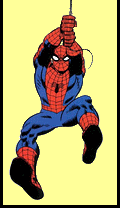 |
|
 SPOTLIGHT
ON SPOTLIGHT
ON
SPIDER-MAN,
THE THING &
THOR
BACK
TO BACK IN A
JANUARY
1976 MARVEL MULTI-MAGS
|
|
|
|
| |
|
| |
AMAZING
SPIDER-MAN #152
MARVEL
TWO-IN-ONE #13
MIGHTY
THOR #243
|
|
 |
|
| |
|
| |
| In the early 1960s, the comic
book industry witnessed two radically different
developments. On the one hand, it saw the hugely
successful comeback of the superhero genre (which had
been clinically dead for most of the 1950s) and a
subsequent streak of new creativity which was met with an
almost unprecedented enthusiasm for the medium.
On the other
hand, the industry's traditional sales points were fading
away, as small stores which had carried comic books for
decades were being pushed out of business by larger
stores and supermarkets. At the same time, newsagents
were increasingly viewing the low cover prices and therefore
tiny profit margins comics
had to offer as a
nuisance. Many ideas on how
to turn these developments around were put forward by
different publishers, but the most successful concepts
strived to open up new sales opportunities and markets
and thus tap into a new customer base.
One place
these potential buyers could be found were the growing
number of supermarkets and chain stores. However, it was
quite clear to DC Comics (who pioneered that particular
concept in 1961) that in order to be able to sell comic
books at outlets such as supermarkets, the product would
have to be adjusted. Handling individual issues clearly
was no option for these outlets, but by looking at their
logistics and display characteristics, DC found that the
answer to breaking into this promising new market was to
package several comic books in a transparent plastic bag.
This resulted in a higher price per unit on sale, which
made the whole business of stocking them much more
worthwhile for the seller. The simple packaging was also
rather nifty because it clearly showed the items were new
and untouched, while at the same time blending in with a
large proportion of other goods sold at supermarkets -
also conveniently packaged.
|
| |
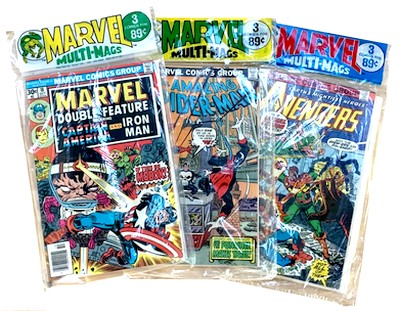
|
|
DC's
"comicpacks" were a success -
so much so that other publishers quickly
started to copy it. Marvel produced a
series of Marvel Multi-Mags in
1968/69 but then seems to have dropped
the idea again. However, by the
mid-1970s,
the House of Ideas had
once again fully embraced the marketing
concept of selling multiple comic books
packaged in a sealed plastic bag to a
customer base which comic books could
hardly reach otherwise: people shopping
at supermarkets and large grocery stores. It didn't really
matter therefore that buying these three
comic books in a comicpack for say 89¢
(rather than from a newsagent for 90¢ in that case) clearly presented no
real bargain - it was the opportunity and
convenience to pick up a few comics at
the same time parents and adults did
their general shopping. Neatly packaged,
it almost became an entirely different
class of commodity.
|
|
|
| |
|
| |
| The MARVEL MULTI-MAGS we are looking at
here features three titles - Amazing Spider-Man #152,
Marvel Two-In-One #13, and Mighty Thor #243,
all from the January 1976 cover date run. This meant they
were actually on sale at newsagents in October 1975,
although there could be quite a delay in terms of actual
availability at some sales points, resulting in
Multi-Mags on display which contained "semi-recent
books (typically about nine months old)"
(Brevoort, 2007). Considering the packaging and
distribution process, this doesn't really seem too
surprising. |
| |
|
There
is no general rule to state what shape/grade the
comic books in a MARVEL MULTI-MAGS (or any other comic pack for
that matter) will be in. After all, a lot of
things can go wrong during their 40+ years of
storage.
Some of these potential mishaps
will only affect the plastic bag, others might
not harm the packaging as much as the contents.
As a result, almost any combination is possible:
you can have a polybag displaying lots of wear
but perfect comic books inside (meaning it was
mostly stored in a dark and cool place but at
some time took some external soiling or slight
mechanical abrasion), but you can just as well
have a near pristine polybag holding comic books
showing substantial paper degradation (indicating
the bag was stored well but exposed to light and
excessive warmth for an extended period of time).
Given its age, the polybag of this
January 1976 MARVEL MULTI-MAGS is rather clean in
comparison to some packagings of the same period,
with only very slight dulling of the plastic and
no spots of colour ink residue from when the
label was turned back onto the bag during some
time of storage (a common "defect"
found on many comicpack bags which, however,
usually doesn't affect the comic books inside the
bag).
The lack of
actual wear on the bag translated well to its
contents; the three individual comic books inside
proved to be in excellent overall condition:
covers with perfect gloss and shine, perfectly
flat and tight (without any spine stress or major
creases), and with sharp edges. Paper
discolouration is somewhat more advanced than
expected (given the good shape of the bag),
indicating exposure of the bag to (very) warm
temperatures during storage. A very slight tinge
of rust on the staples of the two outer comic
books also indicates this MULTI-MAGS spent some time in a
high humidity environment (the centerfold page from Thor
#243 also displays signs of black ink
"footprints", i.e. traces from the feed
mechanism of the printing machine on the sheet of
paper - something which can be seen in a lot of
1970s comic books).
No titles had
permanent slots in the MARVEL MULTI-MAGS, although all three
titles contained in this example - Amazing
Spider-Man, Marvel Two-In-One and Thor
- featured often and regularly. But even so,
given the sometimes seemingly haphazard way
individual issues were selected for inclusion in
MARVEL
MULTI-MAGS,
there was no guarantee of an uninterrupted flow
of consecutive issues - and therefore a distinct
possibility of missing out on a part of the
storyline. On top of this, the continuity of the
Marvel Universe of the 1970s was such that plots
and storylines usually evolved over more than one
issue.
This didn't exactly make the MULTI-MAGS an ideal way of getting
your Marvel comic book fix. However, one needs to bear in
mind that this was a common fate of the average
comic book reader in the 1970s Bronze Age,
whether his or her comic books came packaged in a
plastic bag or as single issues from a display or
spinner rack. Back in those days, an
uninterrupted supply of specific titles simply
was not guaranteed. Not worrying too much about
possible gaps in storylines became something of a
routine - besides, you would usually get a recap
of what had happened so far on the first page.
So
all in all it simply was a part of being a comic
book fan in the 1970s - just as the monthly
Bullpen Bulletins (which were the responsibility
of the editor-in-chief) and the in-house
advertising were.
|
|
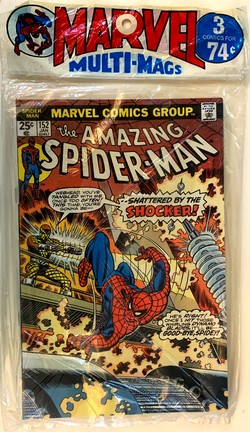
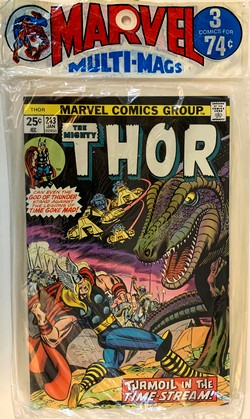
|
|
| |
| The January 1976 Bullpen Bulletin with its by then
typical alliterative and somewhat nonsensical title ("An
idiosyncratic itinerary of intangible illusions and
imaginary ideas intended to illuminate your ID!")
featured a very verbose (and somewhat annoyingly
repetitive) plug by Stan Lee in his regular SOAPBOX column not for a comic
book but for a magazine ("betcha didn't know we
publish a lot of different magazines besides the
comics!"), namely CELEBRITY (Stan's
capital letters). It was essentially Martin Goodman's People
rip-off, launched in 1975 (Howe, 2012), and it probably
needed Lee's plug desperately. In the end, it didn't
work, and Celebrity ceased publication in 1977. As for the actual Bullpen Bulletins' various ITEM!
bullet points, they were all concerned with Marvel's ever
expanding line of titles.
|
| |
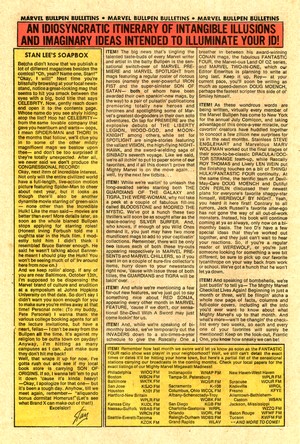
|
|
From a publisher's point
of view it was
a
concerted attempt to push the competition
(most notably DC) off the newsagent racks
by flooding those with Marvel's own
product and enhancing brand recognition
by having a fold of mags which featured Marvel
as part of their title (such as the
new Marvel Presents and Marvel
Feature alongside classics such as Marvel
Team-Up and Marvel Two-In-One). It
worked from a publisher's perspective (by
the end of 1975 Marvel was outnumbering
DC by 47 to 36 titles), but from an
editorial point of view it was a
nightmare as the House of Ideas was
precariously overextending itself. Four
months prior, the September 1975 Bullpen
Bulletin
had highlighted the need for (constantly)
rearranging creative teams in order to
keep from going under; this time around,
readers were told that
"We've
temporarily cut the INVADERS down to
a six-times-a-year schedule to give
the Rascally One a breather in
between his award-winning CONAN mags,
the fabulous FANTASTIC FOUR, the
Marvel-ous Land of OZ series, and
MARVEL TWO-IN-ONE, which our Editor
Emeritus is planning to write at long
last."
At the same time, readers learned that
both Iron Fist and Son of Satan would be
getting their own titles, freeing up
Marvel Premiere
and Marvel Spotlight to become
try-out titles again - with, of course,
the potential for even more characters
spinning out into their own titles.
|
|
|
| |
| Marvel was
clearly winning the numbers game in the "war of the
shelves", but it wasn't sustainable and would
continue to cause massive headaches for its editors over
the next two to three years as issues could simply not be
finished on time. |
| |
|
As new
titles were thrown out, others were cancelled
(most of the horror genre line had been culled by
this time, with the notable exceptions of Tomb
of Dracula and Werewolf by Night),
adding a decidedly confusing spin to things - a "constant
cycle of cancellations and launches"
(Howe, 2012).
Also
included in all three comics collected in this MARVEL MULTI-MAGS was a combined ad for Son of
Origins, the follow-up to Marvel's hugely
successful collaboration with Simon &
Schuster on Origins of Marvel Comics,
and the "Mighty Marvel Bicentennial
Calendar".
Another
combined ad page promoted a "Spidey web
shooter" and the "read along"
comic book and record sets from specialty record
label Peter Pan.
|
|
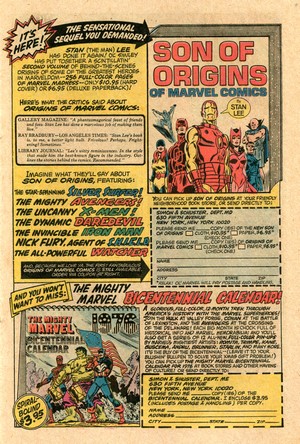 |
|
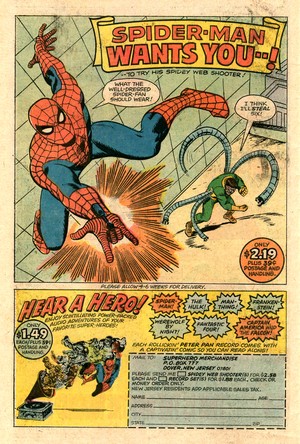 |
|
| |
| Very
similar sets of records and comic books were also
released by Power Records. Both labels were owned by the
same company, Synthetic Plastics Company of Newark NJ. |
| |
| |
|
| |
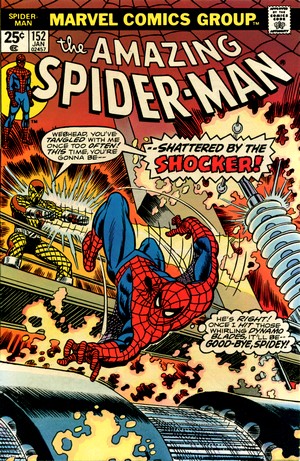
|
|
AMAZING
SPIDER-MAN #152
January 1976
(monthly)
On Sale: 14 October 1975
Editor
- Len Wein
Cover - Gil Kane (pencils) & John
Romita (inks)
"Shattered by the
Shocker!" (18
pages)
Story - Len
Wein
Pencils - Ross Andru
Inks - Mike Esposito, Frank Giacoia
Lettering - John Costanza
Colouring - Glynis Wein
Synopsis
! SPOILER ALERT !
Trapped in the
sewers following a fight with the Shocker
in the previous issue, Spider-Man does
succeed in keeping from drowning by
freeing himself, but the consequences for
Peter Parker have less of a happy ending:
when he finally makes it back to Betty
Brant and Ned Leed's engagement party
(which he had left in a hurry to
intercept the Shocker) he finds
everybody's already left.
|
|
|
| |
| Mary Jane, fuming about
Peter's sudden disappearance, gives him the icy cold
shoulder the next day, so Peter Parker decides to try and
see if the day can be a better one for Spider-Man.
Web-slinging across town he happens to hear a recorded
message from the Shocker, threatening the city with a
blackout unless his ransom demands aren't met. As the
mayor publicly rules out bowing to the blackmailer,
Spider-Man knows trouble is afoot and decides to get
involved. Which is all for the better, since he tracks
down the Shocker at one of the city's power plants. |
| |
| However, he also finds that
he not only has to deal with the Shocker but also
with the security guards, who see Spidey as an
enemy too. But in the end Spider-Man manages to
keep the guards off his back and knock out the
Shocker. Leaving him webbed-up for the police to
find he leaves a note, giving Spider-Man the
credit for defeating the Shocker and thus hoping
for an improvement of his public standing. This Len Wein story (he had
only just started writing the series the previous
issue and would stay on the title until Amazing
Spider-Man #180) has a number of really nice
little touches in making the reader feel a part
of the narrative.

|
|
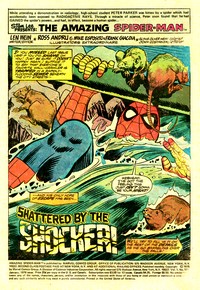 |
|
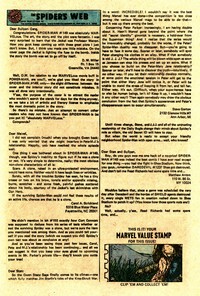 |
|
| |
| Wein also plants the seeds for a number of sub-plots
for future issues, and
Ross
Andru's seasoned artistic experience with the webcrawler
(he had been drawing Spider-Man almost without
interruption since Amazing Spider-Man #125)
provides some truly classic Spider-Man panels,
embellished by two other greats of the trade, Mike
Esposito and Frank Giacoia. |
| |
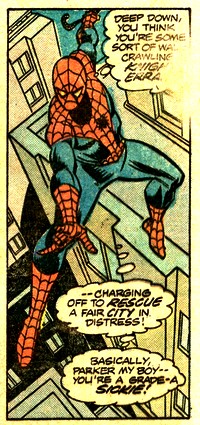 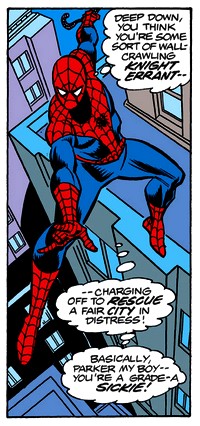 |
|
The
printing techniques employed for comic books in
the 1970s along with the cheap newsprint paper
used really didn't do the artwork much justice,
as a comparison to the rendition in a modern
reprint edition on high quality paper stock
reveals (it also shows the random choice of
colouring involved in a lot of present day
reprint editions).
The
flaws and shortcomings of the mass printing
process often left their marks, and the issue of Amazing
Spider-Man #152 contained in this
MARVEL MULTI-MAG has a few of them. A smudge
across the first word balloon obliterates some of
the text, while the inside back cover displays
another problem of 1970s comic books: ink
bleeding.

|
|
| |
| In this case the advert on the
last interior page has "bled" onto the mostly
white inside back cover, leaving a clearly discernable
mirror image. This is either caused by strong ink
saturation which the newsprint paper could not hold or,
later on, by off-gassing from the acidic pulp paper of
the inside pages. It is a fairly common occurrence in
1960s and 1970s comic books (although usually the effect
is not quite as strong as in this example), and could be
found in comic books straight off the newsagent stands. |
| |
| |
|
| |
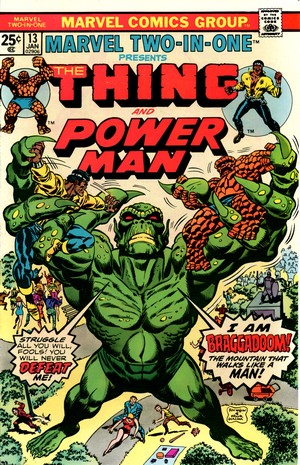
|
|
MARVEL
TWO-IN-ONE #13
January
1976
(bi-monthly)
On Sale:
14
October 1975
Editor - Marv
Wolfman
Cover - Ron Wilson (pencils)
& Frank Giacoia (inks)
"I
Created Braggadoom! The Mountain
that Walked like Man!"
(17 pages)
Story
- Marv Wolfman (plot), Roger
Slifer & Len Wein (script)
Pencils - Ron Wilson
Inks - Vince Colletta
Lettering -
Joe Rosen,
Gaspar Saladino (splashpage)
Colouring - Petra Goldberg
Synopsis
!
SPOILER ALERT !
Luke
Cage has a visitor wanting to
hire his services: one Arnold
Krank, a bio-engineer, who in his
own stuttered words has
accidentally created a creature
(that calls itself Bragadoom,
after the noise it hears when
smashing the Thing into a wall)
that Krank thinks will destroy
everything. Cage rushes to the
assist after learning that the
Thing is already battling
Bragadoom. Together, the two
heroes fight the creature, which
continues to grow in size and
strength, until it expends all
its energy and is reduced back to
its original size.
|
|
|
|
| |
| As Ben Grimm and Luke Cage dust themselves off
and go separate ways, Krank takes the small and infantile
Bragadoom home - where he intends to raise it as his son.
Having
successfully tried out the concept of teaming the Thing
with a different character for a "done-in-one"
story in each issue of Marvel Feature #11-12 (September
and November 1973), Marvel Two-in-One continued that
team-up formula as of January 1974. Clocking up a total
of 100 issues between then and June 1983 (plus seven
Annuals along the way), it was certainly one of Marvel's
most successful team-up titles with a loyal fan
following.
|
| |
|
For its initial twenty issues it
was also one of very few Marvel superhero titles
which stuck to a "done-in-one" formula,
with no overarching plots to speak of. As such, Marvel
Two-In-One was of course ideally suited for
the MARVEL MULTI-MAGS,
given that each issue had a new and
self-contained storyline, and it was indeed a
title to be found very often in MARVEL
MULTI-MAGS throughout the
mid to late 1970s and very early 1980s. The downside
of the single issue stories was their volatility.
Somewhat reminiscent of DC's titles of the 1970s,
heroes and foes would meet, things would happen,
and then everybody just went home. None of what
took place mattered to the next issue, which
would just start the procedural formula all over
again. It didn't inevitably produce whimsical or
even bad stories, but it somehow facilitated
them.
|
|
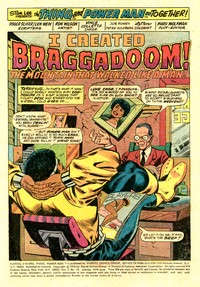 |
|
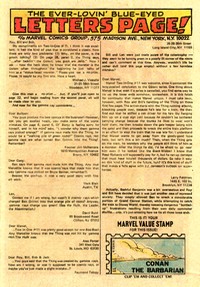 |
|
| |
| At first sight Marvel Two-in-One #13 might
be considered a point in case, making it all the more
baffling how it took three individuals (Marv Wolfman for the plot plus Roger
Slifer and Len Wein for the script) to come up
with a story that makes very little sense and provides
just about the flattest characterization imaginable. |
| |
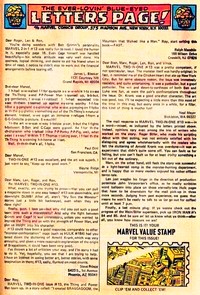
|
|
However, in this case,
there's more to it, as the letters page
of Marvel Two-In-One #15 (May
1976) reveals: the whole thing is a
parody of the 1950s Lee & Kirby
monster stories.
"The mail response to
MARVEL TWO-IN-ONE #13 was - in a word
- mixed, as indicated by the letters
printed above. Indeed, opinions vary
even among the trio of writers who
worked on the story. Roger Slifer,
who made his scripting debut with
that outing, was not entirely
satisfied with his dialoguing and
agrees wholeheartedly with the
readers who felt the stuttering of
Arnold Krank was overdone - it was an
experiment that didn't quite come
off. You can fault us for failing,
but you can't fault us for at least
trying something a bit out of the
ordinary.
Marv, on the other hand, still feels
the story was successful as a
light-hearted romp in the
monster-hunting department, and is
happy that so many readers enjoyed
this rather offbeat terror tale.
Len just waggles his finger in the
direction of production potentate
John Verpoorten's office (...)
Judging from past experience, we
guess that means he won't be ready to
talk to us (...) until at least 7
p.m."
|
|
|
| |
| Ron Wilson - the artist most associated with the
title (due to an extended run on pencils) - provides a
few slick panels and some interesting visuals. But once
again, the cheap newsprint paper didn't render the
artwork too well, and it was especially hard on the
colourist. The original colour guide produced by Petra
Goldberg has very saturated and vibrant colours, possibly
also because the colourist knew that they would be toned
down more than just a tad by the paper quality (or lack
thereof) of the 1976 comic book. The 2017 Masterworks
edition (vol. 2 of Marvel Two-In-One), printed
on glossy paper stock, is a lot closer but displays a few
deviations from the original colouring by Goldberg. |
| |
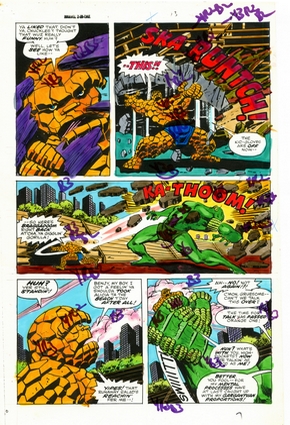 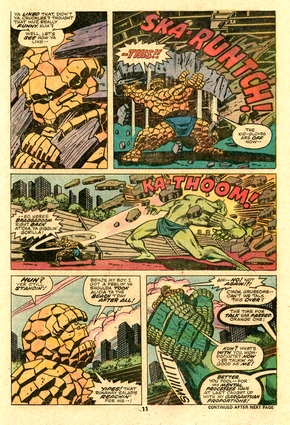

|
| |
|
| |
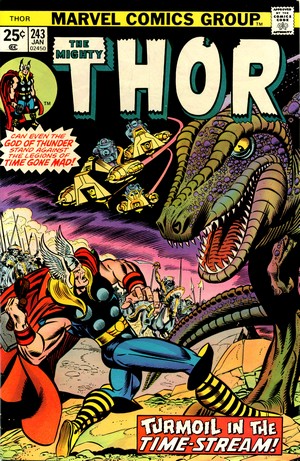
|
|
MIGHTY
THOR #243
January
1976
(monthly)
On Sale: 14 October 1975
Editor - Len Wein
Cover - Gil Kane (pencils) &
Joe Sinnott (inks)
"Turmoil
in the Time-Stream!" (18
pages)
Story - Len Wein
Pencils - John Buscema
Inks - Joe Sinnott
Lettering -
Joe Rosen,
Gaspar Saladino (splashpage)
Colouring - Glynis Wein
Synopsis
!
SPOILER ALERT !
Dr. Artur
Zarrko, a brilliant scientist
from the year 2262, tells Thor
and the Asgardians about the Time
Twisters, beings that travel back
through time from the 80th
Century. And every time they
appear on Earth, it is destroyed.
Agreeing to join Zarrko in his
quest to stop the Time Twisters,
Thor enters the Time Cube along
with Jane Foster and the Warriors
Three.
|
|
|
|
| |
| However, their travel comes
to an abrupt stop when they are attacked in the
Time-Stream by dinosaurs, Mongol warriors, and soldiers
from the future... |
| |
|
After the original plans
to have Roy Thomas script and edit the God of
Thunder's title as of
Thor #239 fell through due to the
aforementioned title expansion and moving around
of creative talent, Len Wein took up the combined
editorial and writing assignment as of Thor
#241, making this his third issue in a run which
would see Wein stay on the title up to issue #271
(May 1978).
Thor #274 would then see the return
of Roy Thomas for a few issues. Wein was thus still building
up his overall plot, and in doing so brought back
Dr. Artur Zarrko, also known as the
"Tomorrow Man" - one of Thor's very
early villains who made his first appearance in Journey
into Mystery #86 (November 1962). Zarrko is
a brilliant but evil scientist from the future
who built a time machine to travel to 1962 and
steal a cobalt bomb, the reason being that the
world of his time (2262) has banned weapons.
|
|
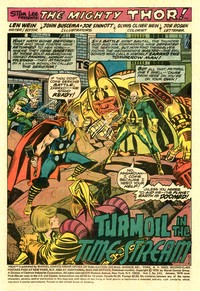 |
|
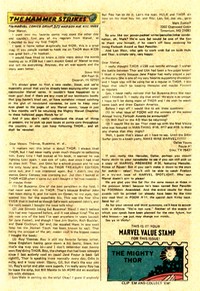 |
|
| |
| The Tomorrow Man appeared again
in Journey into Mystery in 1964 but was then
shelved until Marvel Team-Up #9-11 (May-July
1973). So when Wein brought him back in Thor
#242, he had a nice mix of having a villain with some
(publication) history yet who hadn't been overused. |
| |
|
As
mentioned before, it didn't matter that much in
the '70s if you had missed a previous issue or
two as most editors would bring you up to speed
on the splashpage - or, in this case, fill you in
on "what hath gone before".

The clarity of what was
indeed going on was, of course, also carried and
indeed enhanced by the artwork of "Big"
John Buscema, who had been assigned to Thor from
issues #182 (November 1970) to #259 (May 1977),
shaping the visuals at least as much as Jack
Kirby had done previously. His dynamic pencilling
style suited the Thunder God and his often
mythological and otherworldly settings perfectly
(just as it was the perfect match for Conan)
- just as inker Joe Sinnott was a perfect match.
It was the closest you could get to a cinematic
rendition of Marvel's Thor in the 1970s; Buscema
and Sinnott's work was the equivalent of
Cinemascope, Technicolor and surround sound for
comic books.
|
|
 |
|
| |
| |
|
| |
| No 1970's
Marvel comic book was, of course, without (a lot of)
third party advertising, some of which was
"okay" (mostly if it featured Marvel
characters, such as the frequent and somewhat famous
"Twinkies" ads) and some of which was nothing
but a dismal swamp of the cheapest form of advertising
you could find - such as the infamous flea market ads
promising anything and everything. All three titles
included in this January 1976 Multi-Mag carried almost
exactly the same ads, some of which are illustrated here. |
| |
|
| |
|
 |
|
Today,
any MARVEL MULTI-MAGS is a time
capsule; opening that plastic bag
offers a nostalgic glimpse into
what it was like to be a comic
book reader in the 1970s. And
then as now, the combination of
the three titles in these sealed
polybags could go either way;
sometimes it's all thrills, and
sometimes there's a lemon in
there - or two, if you're really
unlucky. |
|
|
|
| |
|
I
am pretty certain that, back in the days, I would
have considered this January 1976 MARVEL MULTI-MAGS a treasure chest, just
for the titles and main characters alone. No
B-listers in here (although they could be
interesting discoveries), just top billing Marvel
superheroes with Spider-Man, Thor, and the Thing.
Maybe I wouldn't have been quite as thrilled
after reading the three comic books, although I
can't be sure of that, given that comic book
aficionados in their early teens were a lot more
forgiving back in the '70s.
From today's
perspective, however, Amazing Spider-Man
#152 doesn't quite seem to know where it wants to
go - most likely due to the Shocker not
really providing much super-villain oomph.
Although a long standing antagonist of Spider-Man
(making his first appearance in Amazing
Spider-Man #46 in March 1967) who sports
mildly interesting visuals, the way he is handled
here is rather flat and lacklustre. Still, Ross Andru's
artwork on Spidey never disappoints, and the Gil
Kane cover is a classic. A case of the visuals
making up for the story.
Marvel
Two-In-One #13. Okay. At first sight and
read, this really had me wondering what Messieurs
Wolfman, Slifer and
Wein had been thinking, drinking, or otherwise
ingesting. It took a moment for the penny to
drop, and it was only with some afterthought that
I realized that the storyline is so ridiculous
and full of "oh and then this happens, don't
ask how and why" moments because it is, in
fact, the trio doing a spoof of those 1950s Lee
and Kirby Atlas era monster stories. The title (I Created
Braggadoom! The Mountain that Walked like Man!) sort of gives it away too -
after all, there was, for example, "I
created... Sporr! The Thing that could not
Die!" in Tales of Suspense
#11, September 1960, or "I created Krang!
The most fantastic Monster the World has ever
known!" in Tales to Astonish #14,
December 1960. And then the
absent-minded scientist's name... Krank,
meaning "sick" in German. The letters
page of
Marvel
Two-In-One #15 clears it all up beyond a
doubt - but what if you didn't have that issue?
It probably matters more today than it did back
then,
in the mid-1970s,
when I was well versed in those old Atlas monster
stories from reprints in mags such as Chamber
of Chills and Crypt of Shadows, and
I probably wouldn't have thought much of
it and just focused on the somewhat cool look of
the monster - although, is that really what you
think a mountain looks like? Overall, however,
Ron Wilson's artwork (and Vinnie Colletta's inks)
do evoke a 1950s horror comic book feeling, once
you switch to that perspective. The whole thing
is actually rather well done, although some
clearer hints that this is to be seen as a tongue
in cheek piece would probably have helped (such
as a framing story where readers at the end find
out this is actually a story in a monster comic
book a kid is reading?).
Thor
#243 is most likely the best issue in this
polybag, even though it too suffers from
recounting what is merely an intermediate staging
story. But there's action aplenty, and John
Buscema's pencils and Joe Sinnott's inks just
pull you in. I have to admit to having a
soft spot for Thor, so this would probably have
been my favourite comic book from this MARVEL MULTI-MAGS back in the days as
well.
|
|
|
| |
|
FURTHER
READING ON THE THOUGHT
BALLOON |
| |
 |
|
"Comic
packs" not only sold well
for more than two decades, they
also offer some interesting
insight into the comic book
industry's history from the 1960s
through to the 1990s. There's
more on their general history here. |
|
|
|
| |
 |
|
There's more
on the background and the history
of the Marvel Multi Mags here. |
|
|
|
| |
 |
|
By 1976, most
of Marvel's once sprawling line
of horror titles had fallen by
the wayside; there's more on the
House of Idea's "superheroes
from the crypt" here. |
|
|
|
| |
 |
|
The physical
and chemical degradation of 1970s
comic books is, ultimately, an
unstoppable process.
Understanding the driving forces
behind it helps to slow it down
or just simply accept it, and you
can find out more about it here. |
|
|
|
| |
 |
|
There's some
numbers and background
information concerning the
"war of the shelves"
launched by Marvel Comics (and
primarily targeted at DC) here. |
|
|
|
| |
| |
|
| |
| BIBLIOGRAPHY BREVOORT Tom (2007) "Marvel Multi-Mags",
Blah Blah Blog, originally posted 28 April 2007,
reposted 18 April 2020
HOWE Sean (2012) Marvel
Comics: The Untold Story, Harper Collins
|
| |
|
| |



More on comic packs / More on Marvel Multi-Mags
|
| |
|
| |
The illustrations presented here are
copyright material.
Their reproduction for the review and research
purposes of this website is considered fair use
as set out by the Copyright Act of 1976, 17
U.S.C. par. 107.

(c) 2021
uploaded
to the web 19 June 2021
variants of page 11 of Marvel Two-In-One #13
added 15 November 2025
|
| |
|
| |
|






































